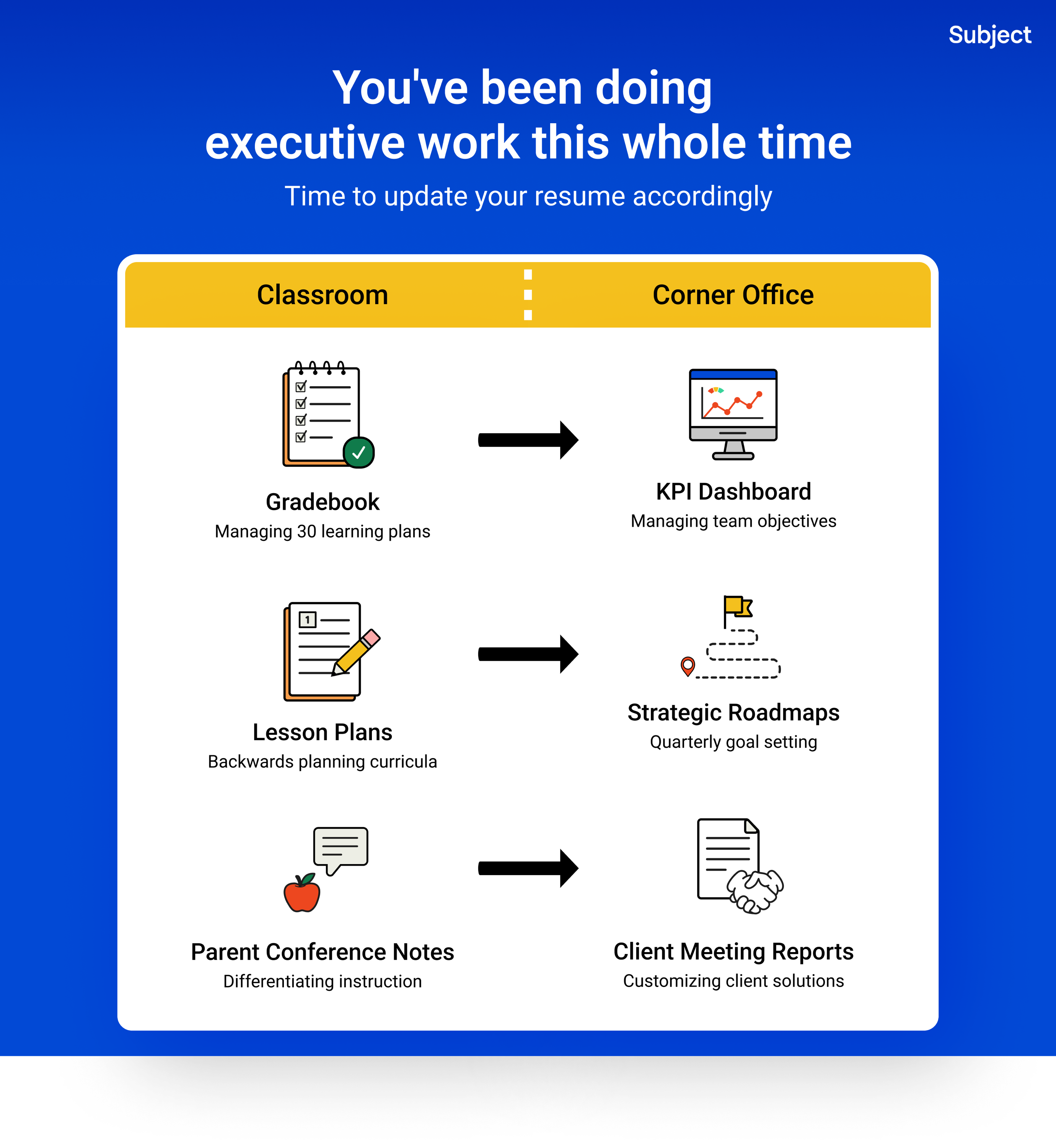Imagine a kindergarten teacher managing 30 five-year-olds, their parents, and district administrators—all while backwards-planning an entire year of Spanish immersion curriculum.
Now imagine that same teacher four years later, closing million-dollar deals with school districts across three states.
That teacher is Ana Romero, and her journey from Lompoc Unified School District (LUSD) classroom to Chief of Staff at Subject says something the education sector desperately needs to hear:
Teachers already possess the executive skills that EdTech companies and district leadership roles demand. They’ve been using them every single day.
Romero spent years teaching Spanish immersion to kindergarteners before transitioning to transforming K-12 education at our online courseware company. Her path from managing five-year-olds to managing multi-state sales partnerships wasn’t a radical career pivot.
It was a natural evolution of skills she’d already mastered.
Teachers Don’t Recognize Their Hidden Executive Value
The education sector faces a paradox.
We need qualified teachers to remain in classrooms, yet we also need professionals with classroom experience leading districts, EdTech companies, and education policy. But when teachers feel bogged down in classroom resources, student needs, IEPs, parent meetings, and teaching core standards, they may feel unable to translate their classroom experience to a resume for another type of role.
Classroom competency requires constant and explicit planning. “Teachers always have their objectives and their goals very clearly aligned,” Romero notes. That focus on daily goals, and minute-to-minute student needs, shouldn’t stop your ability to see a future outside the classroom.
Teachers are great at presenting and making the old curriculum feel fresh. If you think teachers can’t find a new way to teach geometry, guess again. The best teachers have easily transferable skills like:
- Managing multiple constituencies with competing needs
- Breaking down complex goals into achievable milestones
- Making fifty micro-decisions in real time, all for a larger vision
“I think the one thing that teachers have to realize that they have is they’re great at customer service,” Romero explains. “Because they’re dealing with so many family members at the same time, and they have to make sure those families are happy.” They’re high-level strategic planners who happen to work in classrooms.

Four Steps From Classroom to Corner Office
The hypothesis teachers should embrace to make leadership moves in their careers: managing children and managing adults aren’t fundamentally different challenges.
The transition from classroom to boardroom follows a natural progression when teachers recognize and reframe their existing competencies. According to Romero, it requires four key steps:
Step 1: Reframe Your Stakeholder Management Experience
Teachers don’t manage one classroom—they manage up to 250 individual learning plans while satisfying parents, administrators, and state requirements simultaneously. This mirrors exactly what district leaders and EdTech executives do when balancing teacher needs, student outcomes, and budget constraints.
Step 2: Scale Your Planning Timeline
“You’re thinking a year in advance,” Romero explains about her role now. “What is the goal that we need to have done in a year, and then how do we backwards plan?”
Teachers already excel at backwards planning—they map entire semesters to final mastery assessments. The shift involves extending that timeline from semesters to fiscal years, from unit plans to product roadmaps.
Step 3: Leverage Your Unique Credibility
Former teachers possess something pure business professionals lack: authentic understanding of classroom reality. Romero discovered this advantage immediately in sales conversations.
“A lot of people in education are not savvy business folks,” she observes, but this is a good thing for businesses that serve education. Districts immediately trust former teachers differently than they trust traditional salespeople. This credibility opens doors and accelerates trust-building in ways that save months of relationship development.
Step 4: Apply Classroom Skills to Team Dynamics
“There’s a lot more delegation that happens,” Romero notes about leadership roles. “People skills are extremely important. And actually, that’s something teachers can always work on.”
Teachers who’ve managed classrooms where “one student is in a bad mood, so now the other three students around them can’t focus” understand team dynamics at a granular level. They’ve spent years reading rooms, managing energy, and maintaining productivity despite constant disruptions.
The Superpower Only Teachers Have
Teachers understand how humans actually learn and change.
They’ve spent years observing resistance, breakthrough moments, and behavior modification. Applied to organizational settings, these insights transform how companies approach training, change management, and culture development.
The implications extend beyond individual career transitions:
- Education needs teachers in leadership positions—not despite their classroom experience, but because of it.
- Districts need superintendents who remember what third period actually feels like.
- EdTech companies need product leaders who understand why teachers abandon platforms after two weeks.
- Policy makers need advisors who’ve actually tried implementing their brilliant ideas with real students.
Teachers shouldn’t look at this career pivot into executive or leadership positions as “abandoning” education, but as scaling their impact.
They’re taking skills forged in impossible conditions (teach reading while managing behavior while satisfying state standards while keeping parents happy) and applying them where they’re desperately needed.
The bottom line is teachers haven’t been preparing for executive roles. They’ve been doing executive work under harder conditions than most executives ever face.
They’ve been managing more stakeholders, juggling more priorities, and delivering more consistent outcomes with fewer resources than their corporate counterparts.
Every teacher wondering whether they’re qualified for that district position, EdTech role, or policy job should know: You’re not qualified. You’re overqualified. You’ve been training for this your entire career.
You called it “teaching.”
